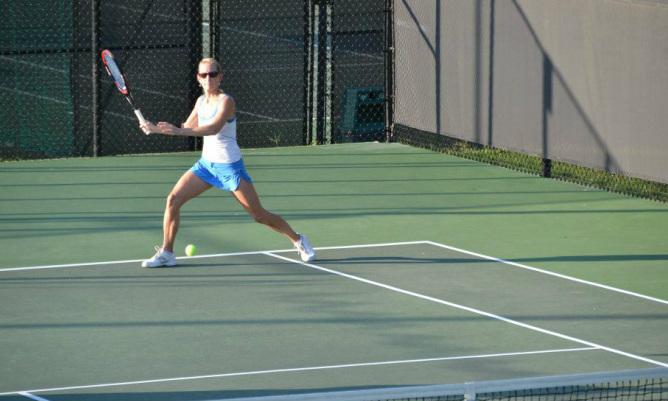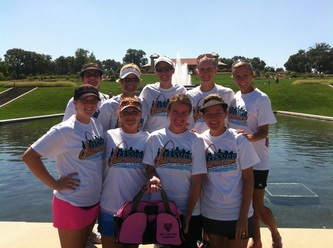I just completed two weekends of tennis tournaments without a migraine! I realize not every migrainuer plays tennis. Whether you want to run, bike, hike a mountain, or do whatever form of activity you love, avoiding a migraine means you must properly prepare.
Before beginning my migraine plan I spent tournament weekends overusing triptans and caffeine in an attempt to just make it through the weekend. Then I would spend days trying to recover from the weekend in a dark room with ice wrapped around my head. I am now able to make it through my tournament weekend through proper preparation.
The difficulty playing in tennis tournaments (and many other sports or activities) for the migrainuer lies in the high temperatures (1), the change in activity level (2), and possible dehydration (3). All three of these factors are physical stressors and require proper preparation in order to overcome them.
1. High Temperatures: The weather in Oklahoma did not reach 100 degrees until a week before the tournaments began. Although the beautiful 80 degree weather up until now provided many comfortable days of tennis it did not give me the opportunity to acclimate to the 100 degree weather I encountered for the tournaments. Another important temperature fact about tennis is that you add 10-15 degrees to the temperature when playing on hard court surfaces (which I did this past weekend). Since I spend most my days in a well shaded air-conditioned room, preparing for the tournament means I needed to start acclimating to a sunny 110 degree environment. Most of the time as a migrainuer I avoid heat and exercise because it is a migraine trigger. However tournament officials don't appear to care about my migraine brain so at least one of my match times will be in the middle of the day and at peak heat. Since no one has invented a weather machine yet, I must acclimate to this hot environment. The experts say that it takes about 7-14 days to acclimate to temperature changes. My acclimation plan started with adding a walk into my routine at the hottest possible time (around 5 p.m.). I gradually increased the length of my walks in the heat in order to slowly acclimate and avoid an exertion level that would trigger a migraine.
2. Change in Activity Level: Any change for a migrainuer can be a trigger. Stressing our bodies to do something that they aren't accustomed to whether it is staying awake too long or skipping meals can put us over the edge. Tennis tournaments mean an unpredictable amount of activity. A highly competitive third set match could possibly mean I am on the court for over two hours. Since we play two matches a day, I may be playing four hours of tennis a day. Trust me when I say that I never play four hours of tennis a day. What I can do is make sure my body is well-conditioned. I get on my treadmill or bike whenever I can squeeze in an extra 45 minutes of cardio in order to prepare my body physically. Only one Saturday before the tournaments began was I able to play tennis twice in one day.
3. Possible Dehydration: Properly hydrating is extremely important for exercising in the heat. Headaches are a main symptom of heat exhaustion. Heat exhaustion is brought on by high temperatures, humidity and overexertion. Body water is what keeps us cool. If you allow your body to dehydrate you can't sweat enough to keep from overheating. I start hydrating the week before the tournament. My goal is to never be thirsty and to pee clear. The day of the tournament I wake up drinking water. I drink two full 16 oz. waters before I get to the courts. The Sport Medical Advisory Committee recommends you drink another 8 to 16 oz. of water 15 minutes prior to your event. They also recommend drinking 4 to 8
oz. of fluid every 15 to 20 minutes during your event. I drink as much as possible at every change over. Their recommendation for after events is to drink 16 to 20 oz. of water for every pound lost before the next competition (I will not be weighing myself at the courts). I plan to drink as much water as possible and seek shade (if I can find some) between and during matches. The recommendation regarding sports drinks is that they may provide additional benefits with "prolonged continuous or intermittent activity of greater than 45 minutes, continuous or repeated exertion, and in warm-to-hot and humid conditions". The problem with sports drinks for the migrainuer is that the ingredients are many times migraine triggers. The idea behind sports drinks is to give an athlete both carbohydrate along with electrolyte replacement during the event. This migrainuer will stock some cherry juice in my cooler to sip on if I need some carbohydrate and carry a salty snack for sodium replacement.
Happy Hot Exercising--I hope my experience will help better prepare another migrainuer for exercising in the heat.
Before beginning my migraine plan I spent tournament weekends overusing triptans and caffeine in an attempt to just make it through the weekend. Then I would spend days trying to recover from the weekend in a dark room with ice wrapped around my head. I am now able to make it through my tournament weekend through proper preparation.
The difficulty playing in tennis tournaments (and many other sports or activities) for the migrainuer lies in the high temperatures (1), the change in activity level (2), and possible dehydration (3). All three of these factors are physical stressors and require proper preparation in order to overcome them.
1. High Temperatures: The weather in Oklahoma did not reach 100 degrees until a week before the tournaments began. Although the beautiful 80 degree weather up until now provided many comfortable days of tennis it did not give me the opportunity to acclimate to the 100 degree weather I encountered for the tournaments. Another important temperature fact about tennis is that you add 10-15 degrees to the temperature when playing on hard court surfaces (which I did this past weekend). Since I spend most my days in a well shaded air-conditioned room, preparing for the tournament means I needed to start acclimating to a sunny 110 degree environment. Most of the time as a migrainuer I avoid heat and exercise because it is a migraine trigger. However tournament officials don't appear to care about my migraine brain so at least one of my match times will be in the middle of the day and at peak heat. Since no one has invented a weather machine yet, I must acclimate to this hot environment. The experts say that it takes about 7-14 days to acclimate to temperature changes. My acclimation plan started with adding a walk into my routine at the hottest possible time (around 5 p.m.). I gradually increased the length of my walks in the heat in order to slowly acclimate and avoid an exertion level that would trigger a migraine.
2. Change in Activity Level: Any change for a migrainuer can be a trigger. Stressing our bodies to do something that they aren't accustomed to whether it is staying awake too long or skipping meals can put us over the edge. Tennis tournaments mean an unpredictable amount of activity. A highly competitive third set match could possibly mean I am on the court for over two hours. Since we play two matches a day, I may be playing four hours of tennis a day. Trust me when I say that I never play four hours of tennis a day. What I can do is make sure my body is well-conditioned. I get on my treadmill or bike whenever I can squeeze in an extra 45 minutes of cardio in order to prepare my body physically. Only one Saturday before the tournaments began was I able to play tennis twice in one day.
3. Possible Dehydration: Properly hydrating is extremely important for exercising in the heat. Headaches are a main symptom of heat exhaustion. Heat exhaustion is brought on by high temperatures, humidity and overexertion. Body water is what keeps us cool. If you allow your body to dehydrate you can't sweat enough to keep from overheating. I start hydrating the week before the tournament. My goal is to never be thirsty and to pee clear. The day of the tournament I wake up drinking water. I drink two full 16 oz. waters before I get to the courts. The Sport Medical Advisory Committee recommends you drink another 8 to 16 oz. of water 15 minutes prior to your event. They also recommend drinking 4 to 8
oz. of fluid every 15 to 20 minutes during your event. I drink as much as possible at every change over. Their recommendation for after events is to drink 16 to 20 oz. of water for every pound lost before the next competition (I will not be weighing myself at the courts). I plan to drink as much water as possible and seek shade (if I can find some) between and during matches. The recommendation regarding sports drinks is that they may provide additional benefits with "prolonged continuous or intermittent activity of greater than 45 minutes, continuous or repeated exertion, and in warm-to-hot and humid conditions". The problem with sports drinks for the migrainuer is that the ingredients are many times migraine triggers. The idea behind sports drinks is to give an athlete both carbohydrate along with electrolyte replacement during the event. This migrainuer will stock some cherry juice in my cooler to sip on if I need some carbohydrate and carry a salty snack for sodium replacement.
Happy Hot Exercising--I hope my experience will help better prepare another migrainuer for exercising in the heat.







 RSS Feed
RSS Feed
